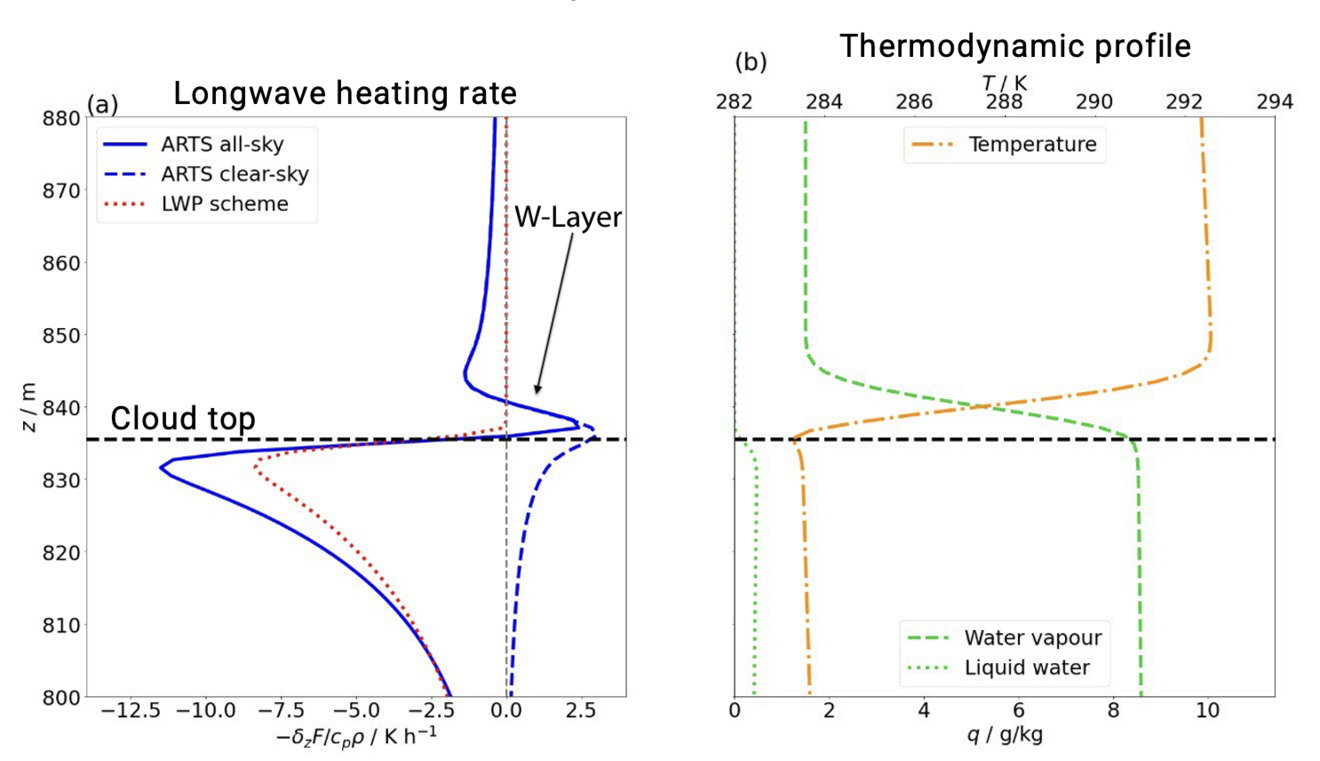Kenneth Chan
| Department | IMPRS |
| Group | IMPRS doctoral candidate |
| Position | Phd Candidate |
| phone | +49 40 42838-5331 |
| kenneth.chan@mpimet.mpg.de | |
| Room | G 1639 |
Research
Unveiling the hidden "W-Layer"
Simulations at metre-scale resolution are required to resolve the finest details and variability at the stratocumulus cloud top. Many of these simulations adopt simplified radiative transfer models due to computational constraints. A common simplification is to only consider the liquid water path. The longwave radiative transfer by water vapour and carbon dioxide at the metre-scale has been rarely documented or addressed.
Using the detailed line-by-line radiative transfer model ARTS (Buehler et al., 2018, 2025) and a metre-scale thermodynamic profile derived from the DYCOMS-II campaign, we discover a 5-metre layer, which we term as the “W-Layer”, above the stratocumulus cloud top, warming at about 2 K h-1. The W-Layer establishes through clear-sky radiative effects. Water vapour and carbon dioxide exchange heat across the capping inversion with a stark temperature contrast. The W-Layer is so thin because the radiative warming by the water vapour and carbon dioxide is masked by the cloud top radiative cooling by the liquid water in the cloud layer. This poses observational challenges and the W-Layer was therefore hitherto unknown.
The structure of the W-Layer is mostly determined by the inversion strength. The stronger the gradient or the magnitude of the inversion, the higher the warming rate in the W-Layer. Per contra, the W-Layer is only weakly sensitive to the concentration of water vapour or carbon dioxide.
Our discovery of the W-Layer reveals a blind spot in stratocumulus simulations. Low-resolution simulations which can afford preciser radiation models cannot resolve the W-Layer. High-resolution simulations which resolve metre-scale features but adopt parametrised radiation models also fail to represent the W-Layer due to the design of the parametrisation. Efficient radiation models which consider clear-sky effects must be introduced to metre-scale simulations, such that we can investigate the effects of the W-Layer on the boundary layer.
Supervisors: Prof. Juan Pedro Mellado, Prof. Stefan Bühler

Curriculum Vitae
Education
Since 2023: PhD Candidate at the Max Planck Institute for Meteorology, Hamburg, Germany
2021 - 2023: MSc Atmospheric and Climate Science, ETH Zurich, Zurich, Switzerland
- Thesis: Evaluating Potential Impact of Seeding Tropical Cyclones with Aerosols in the Numerical Model ICON
2016 - 2021: BSc Physics (1st major) and Earth System Science (2nd major), The Chinese University of Hong Kong, Shatin, Hong Kong
- 1st Thesis: Probability of Occurrence of Strong and Gale Force Winds in Hong Kong during the Passage of Tropical Cyclones
- 2nd Thesis: Tropical Cyclone Intensity Forecast using ECMWF EPS with Machine Learning
Practical Experience
2019 - 2020: Student Intern at Hong Kong Observatory, Tsim Sha Tsui, Hong Kong
- 1st Project: Machine Learning in Calibrating Tropical Cyclone Intensity Forecast of ECMWF EPS
- 2nd Project: Enhancing Automatic Weather Forecast System (Wind & Thunderstorm)
- 3rd Project: Probability of Occurrence of Strong and Gale Force Winds in Hong Kong during the Passage of Tropical Cyclones
Teaching
2021: Teaching Assistant of the course "Ecosystems and Climate" at The Chinese University of Hong Kong, Shatin, Hong Kong
Publications
Chan, M. H. K., Wong, W. K., & Au-Yeung, K. C. (2021). Machine learning in calibrating tropical cyclone intensity forecast of ECMWF EPS. Meteorological Applications, 28(6), e2041. https://doi.org/10.1002/met.2041
Master's Thesis
Chan, K. (2023): Evaluating Potential Impact of Seeding Tropical Cyclones with Aerosols in the Numerical Model ICON
- Supervisors: Prof. Ulrike Lohmann & Nadja Omanovic
Bachelor's Thesis
Chan, M. H. K. (2020): Probability of Occurrence of Strong and Gale Force Winds in Hong Kong during the Passage of Tropical Cyclones
- Supervisors: Prof. Francis Tam & Chun-wing Choy
Chan, M. H. K. (2020): Tropical Cyclone Intensity Forecast using ECMWF EPS with Machine Learning
- Supervisors: Prof. Francis Tam & Wai-kin Wong
